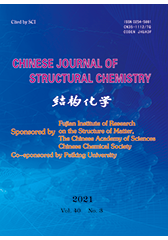Synthesis, Crystal Structure, Theoretical Calculation, and Photophysical Property of a New Cd(II) Complex Based on N-heterocyclic Ligand and Isophthalic Acid
YAN Li*, MENG Xue, XU Yue and LIU Wei*
Chin. J. Struct. Chem. 2021, 40, 329-335 DOI: 10.14102/j.cnki.0254-5861.2011-2864
March 15, 2021
Cd(II) complex, crystal structure, fluorescence, theoretical calculation
ABSTRACT
A new metal-organic coordination complex [Cd(imp)(m-bdc)]n (1, ipm = 5-(1H-imidazo[4,5-f][1,10] phenanthrolin-2-yl)-2-methoxyphenol, m-bdc = isophthalic acid) has been synthesized by hydrothermal reaction and characterized by elemental analysis, thermogravimetric (TG) analysis, infrared spectrum (IR) and single-crystal X-ray diffraction. Complex 1 crystallizes in monoclinic, space group C2/c with a = 15.373(5), b = 16.719(5), c = 19.406(6) Å, β = 106.995(5)°, V = 4770(2) Å3, C28H18CdN4O6, Mr = 618.86, Dc = 1.724 g/cm3, μ(MoKα) = 0.971 mm–1, F(000) = 2480, Z = 8, the final R = 0.0391 and wR = 0.1044 for 4701 observed reflections (I > 2σ(I)). Single-crystal X-ray diffraction reveals that 1 exhibits a one-dimensional (1D) double-chain architecture, and the H-bond intersections link the 1D double-chain architecture into a 2D layer structure. TG analysis shows clear courses of weight loss, which corresponds to the decomposition of different ligands. We also study the luminescent properties of complex 1. In addition, to elucidate the essential electronic characters of this complex, theoretical calculation analysis was performed by the PBE0/LANL2DZ method in Gaussian 03 Program.








